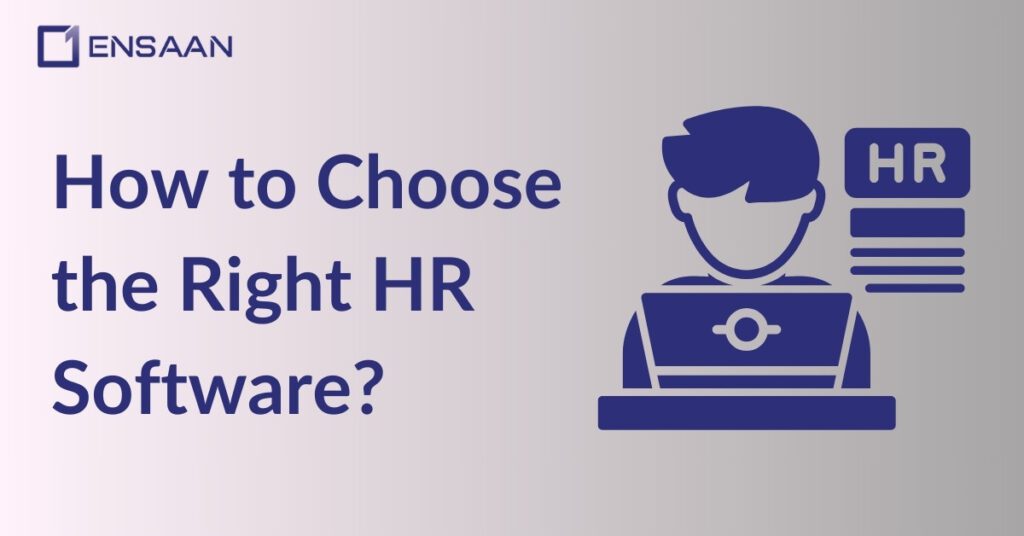Choosing a Right HR software solution is a crucial decision for any business.
Your HR team life can be simplified, saving both time and improving employee management.
Due to so many options, it can be difficulty to choose the right option.
This guide will cover everything you need to know to choose the Right HR software solution for your company.
We will explore what HR software is, its advantages, how to select an ideal one and some top tools worth keeping an eye out for.

What is HR Software?
HR software is a digital tool used by businesses to manage and automate HR tasks such as:
- Employee records should be stored safely.
- Manage payroll and benefits effectively.
- Hiring and onboarding new employees.
- Tracking employee performance.
- Handling requests for time-off.
Most HR software is cloud-based, meaning you can access it online from anywhere at any time.
Your HR tasks can now be completed more quickly and effortlessly, freeing your team to focus on more strategic initiatives aimed at improving employee experience and engagement.
How is HR Software Used?
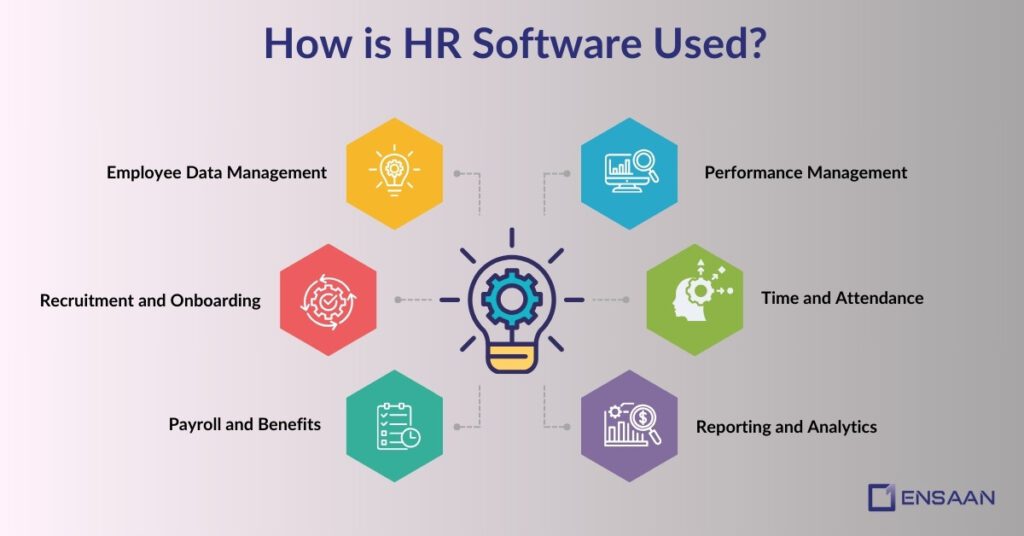
HR software is commonly used by companies to streamline paper-based processes and automate repetitive tasks. Here are a few ways th
HR software is commonly used by companies to streamline paper-based processes and automate repetitive tasks. Here are a few ways that companies utilize this type of solution:
- Employee Data Management: Keep all employee details organized in one convenient place for easy updates and access.
- Recruitment and Onboarding: Let us assist your company in quickly hiring, onboarding, and training new employees efficiently.
- Payroll and Benefits: Automating payroll calculations while overseeing employee benefits like health insurance is now easier than ever!
- Performance Management: Monitor employee progress and offer feedback.
- Time and Attendance: Records employee work hours and manages time-off requests efficiently.
- Reporting and Analytics: Deliver reports to help make better business decisions.
HR software simplifies HR tasks, saves time and helps your team work more effectively.
Benefits of Using HR Software
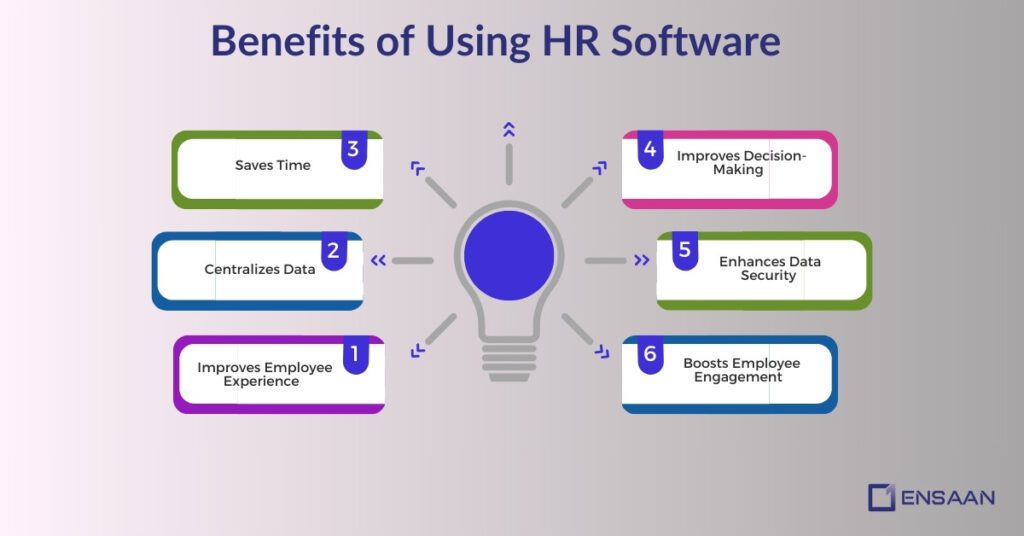
Hiring HR software offers businesses many benefits. Here are a few of them:
1. Improves Employee Experience:
HR software facilitates employee access to important data such as payslips, vacation days and benefits – this facilitates better communication and makes employees feel valued by their employer.
2. Centralizes Data:
HR software makes managing employee information much simpler by centralizing everything into one location – making it simpler to find and organize information quickly.
3. Saves Time:
HR software automates repetitive tasks like payroll, time tracking, and onboarding. This frees up your HR team to focus on more strategic work.
4. Improves Decision-Making:
Using HR software allows you to generate reports and analyze data to make sound business decisions. For instance, tracking employee turnover or identifying training needs becomes much simpler with HR software at your disposal.
5. Enhances Data Security:
HR software safeguards employee data with encryption and access controls to reduce the risk of data breaches.
6. Boosts Employee Engagement:
By streamlining HR processes, employees can focus on their work instead of administrative duties – leading to greater job satisfaction and retention.
How to Choose the Right HR Software?
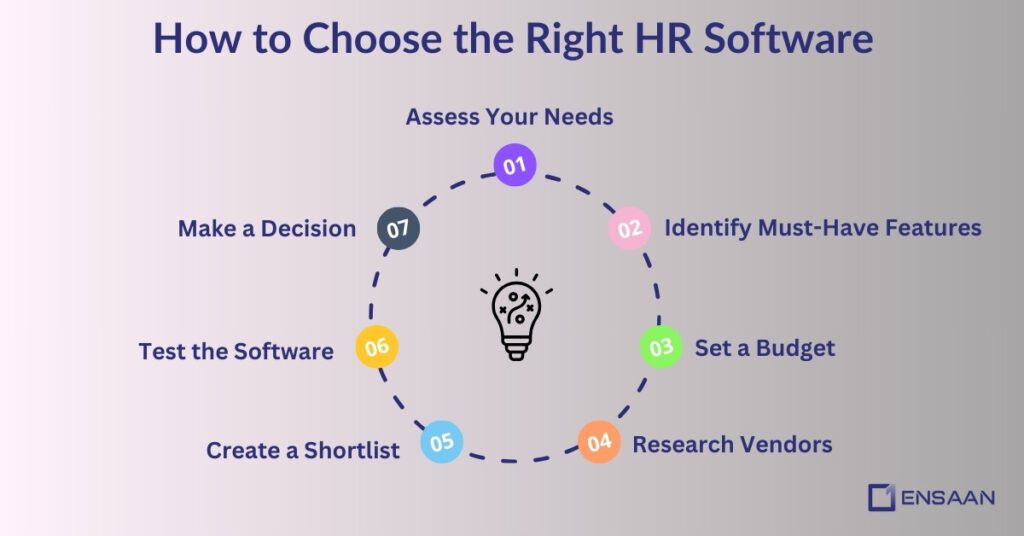
Choosing the right HR software can feel like a big task, but it doesn’t have to be. Follow these steps to find the best tool for your business:
Step 1: Assess Your Needs:
Before you start looking at software, think about what your business needs. Ask yourself:
- What HR tasks are taking up too much time?
- Are there any processes that need improvement?
- What’s your budget for HR software?
- How many employees will use the software?
- Do you need a tool for recruitment, payroll, or performance management?
By answering these questions, you’ll have a clear idea of what you’re looking for.
Step 2: Identify Must-Have Features:
Make a list of features most relevant to you; this may vary depending on the needs and wants of each business, but here are some common ones:
- Employee Self-Service: Allows employees to access their own data such as payslips and vacation days directly through an employee self-service system.
- Recruitment Tools: For finding, recruiting and onboarding new employees.
- Payroll Management: Automates payroll calculations and tax filings.
- Benefits Administration: Administer employee benefits such as health insurance and retirement plans.
- Performance Management: Track employee progress and provide constructive feedback.
- Time and Attendance: Track employee work hours and manage time-off requests efficiently.
- Reporting and Analytics: Develops reports to assist with making smarter business decisions.
- Integration: Your accounting or project management software works seamlessly with other tools you use, like accounting or project management software.
Step 3: Set a Budget:
HR software typically falls between $25 to $80 monthly depending on features and the size of your business.
When setting a budget, take these considerations into account when allocating resources:
- The upfront cost of the software.
- Any additional fees for setup, training, or support.
- The return on investment (ROI) you expect from the software.
Be sure to include key decision makers from both finance and HR when creating your budget.
Step 4: Research Vendors:
Once you understand your needs and budget, research vendors.
Here are a few strategies for finding the most appropriate options:
- Read buyer’s guides and comparison articles.
- Check reviews on sites like G2 or Capterra.
- Ask for recommendations from other businesses in your industry.
- Look for case studies to see how the software has helped other companies.
Step 5: Create a Shortlist:
After researching, narrow down your options to 3-5 tools that meet your needs and budget. Compare them based on:
- Features.
- Ease of use.
- Customer reviews.
- Pricing.
Step 6: Test the Software:
Take advantage of free trials or demos offered by most HR software vendors to test how well the software works and find out exactly how it operates. Here’s what to watch out for during a demo:
- Is the software easy to use?
- Does it have all the features you need?
- How does it handle your specific HR tasks?
- Is the customer support helpful?
Involve your HR team in the testing process to get their feedback.
Step 7: Make a Decision:
Once you have evaluated various software solutions, select the one that meets your specific requirements best.
Get HR on board as early as possible; provide training as required and consider availing yourself of any onboarding support options offered by vendors to ease implementation.
Key Features to Look for in HR Software
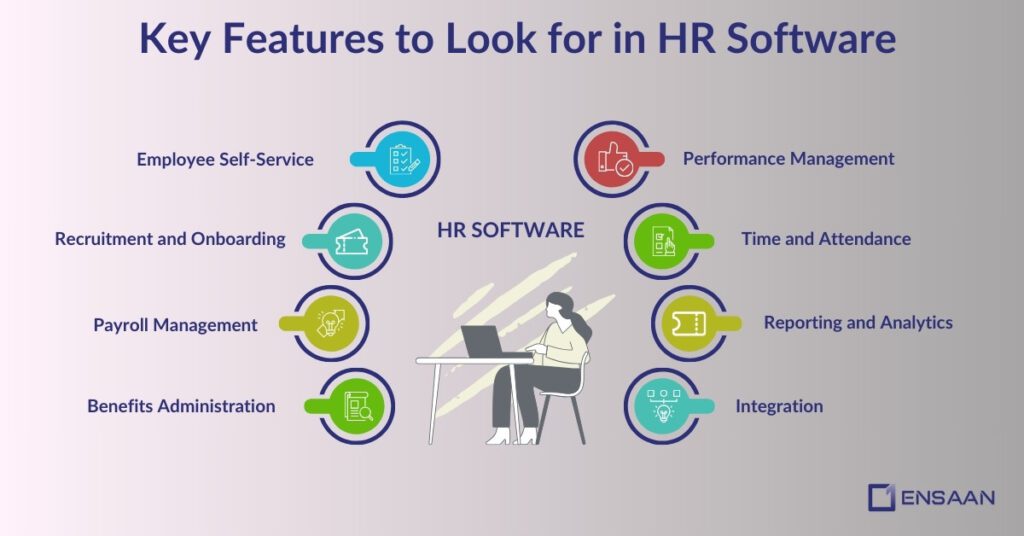
Here are some essential features to consider when choosing HR software:
1. Employee Self-Service:
Employee Self-Service allows employees to gain access to their own information such as payslips, vacation days and benefits at any time, reducing HR workload while increasing employee satisfaction.
2. Recruitment and Onboarding:
Recruitment tools help your business to quickly identify and recruit top talent. Onboarding features make training new employees easy so that they can quickly adapt.
3. Payroll Management:
Payroll tools automate calculations, tax filings and payments on time with reduced errors – saving both time and effort in the process.
4. Benefits Administration:
This feature allows you to easily manage employee benefits like health insurance, retirement plans and bonuses – an integral component in maintaining employee happiness and engagement.
5. Performance Management:
Performance tools allow employers to monitor employee progress, set goals and offer feedback to quickly identify top performers as well as areas that could use improvement.
6. Time and Attendance:
Time tracking tools provide accurate payroll calculations while helping manage schedules more effectively.
7. Reporting and Analytics:
Reporting tools generate custom reports to help you analyze data and make better business decisions.
For example, tracking employee turnover or identifying training needs could all benefit from using reporting tools.
8. Integration:
Your HR software should integrate seamlessly with other tools you use for business management such as accounting or project management software, making it simpler to oversee all processes at one central place.
Top 5 HR Software Options
Here are 5 top HR software tools you may want to consider for your HR software solution needs:
1. PeoplesHR:
PeoplesHR is an easy and user-friendly HR platform designed for small to medium-sized businesses that handles recruitment, onboarding and employee management needs.
Key Features:
- Employee database.
- Recruitment and onboarding tools.
- Performance management.
- Time-off tracking.
2. Adrenalin:
Adrenalin focuses on payroll and benefits administration with an easy user experience that simplifies tax filings.
Key Features:
- Payroll management.
- Benefits administration.
- Time tracking.
- Employee self-service.
3. HiBob :
HiBob is an innovative HR platform that makes managing employee data and increasing engagement easy and effective.
Key Features:
- Employee database.
- Performance management.
- Time and attendance tracking.
- Customizable workflows.
4. Rippling:
Rippling offers all-in-one HR, payroll, and IT management functionality to provide businesses with an all-inclusive solution.
Key Features:
- Payroll and benefits.
- Employee onboarding.
- IT management.
- Time tracking.
5. TriNet:
TriNet is ideal for small businesses. It handles payroll, benefits, and compliance.
Key Features:
- Payroll management.
- Benefits administration.
- Risk mitigation.
- HR consulting.

Conclusion
Choosing the Right HR software can have a lasting impact on your business.
Follow this guide steps and you will find a tool that meets both your needs and budget requirements.
Make sure that you include your HR team in the decision-making process and test any software before reaching a definitive decision.
With the right HR software, you can streamline HR tasks, enhance employee experiences and focus on growing your business.
FAQ
A digital tool to manage HR tasks like payroll, recruitment, and employee data. It’s cloud-based and saves time.
Benefits of HR Software are that it saves time by automating tasks, keeps employee data organized, improves employee experience, and protects data with strong security.
Yes! Many tools are affordable and designed for small teams.
The features to look for in HR Software are Employee self-service, Recruitment and onboarding, Payroll and benefits management, Performance tracking, Time and attendance, Reporting and analytics, and Integration with other tools.

